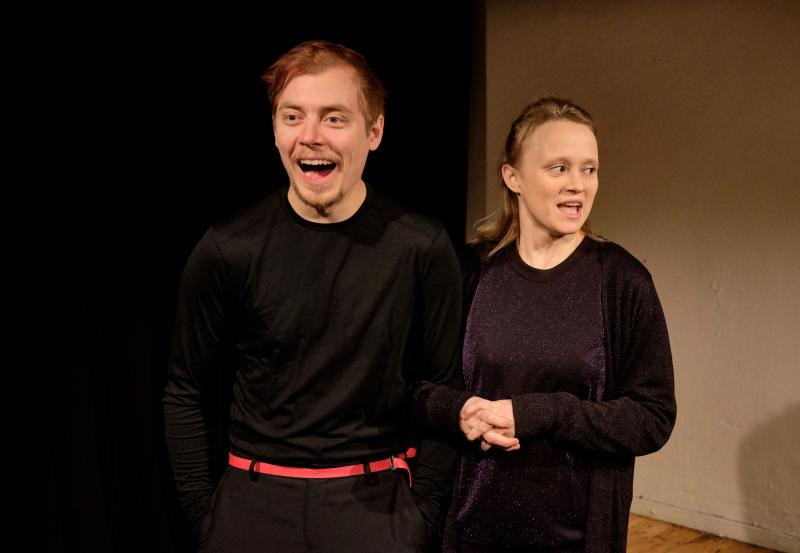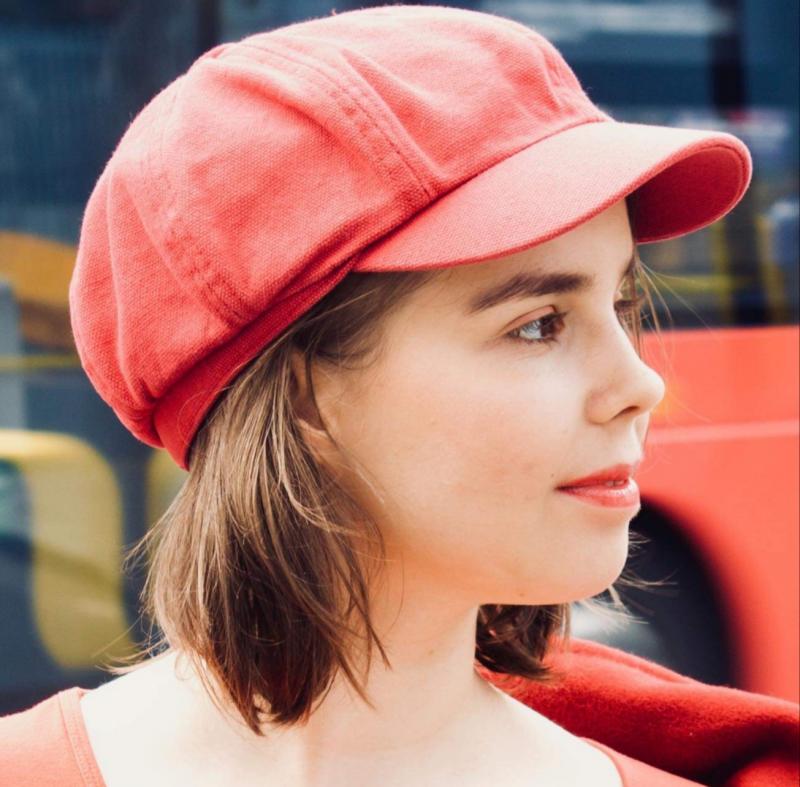Review: NISKAVUORI'S HETA at Theatre Jurkka
I went to the the pre-performace of Niskavuori's Heta (Niskavuoren Heta) at Theatre Jurkka on 11.1.2019. And I'm glad I did.
Niskavuori's Heta is utterly great, captivating and concerted performance that celebrates the importance of a good story and language in a play, topped up with flexible, talented actor duo.
From this point on a fuller review with some more detailed descreption. Minor spoilers!
The performance is utterly great "Couch theatre", as we say in Finnish, which means that the actors work very close to the audiece in a smallish room. There were around 50 seats in total.

Photo: Marko Mäkinen, 2019.
The actors have a great balance
Eero Ojala (left) Ella Mettänen (right)
The performance started when a curtain was drawn with an attidute to block the view to the lobby. Ella Mettänen is on stage. Her acting style is soft and tranquil and she wears dark purple and a black gown. A sickle and its link to a womanhood and death in the 19th century is something mentioned in the programme, and also later is seen as a prop on stage. That in mind the gown is a very good outfit pick and purple is a color of royalty. Soon Eero Ojala steps in. He has details in red and his acting style is more intense and expressive.
These actors' styles and their clothes balace each other quite well: soft and intense, purple and red.
As one would expect in a Couch theatre performace, the fourth wall is being broke rather soon. Our actors switch between roles in a mesmerising, well rehearsed way. The space is small and nothing misses a keen eye, which nevertheless is under the influence of good directing and choreography: if a character goes behind a chair, he simply dissapears, even though we still could see parts of him. If nothing else but fingers move on stage, we'll automatically look at those fingers. One growling character even did some sign language, too, on top of his speaking, which was a marvellous detail, not to be left as the only one.
The performance does play with our attention: small utterings from the performers force us to be more attentive, and small changes in a way of speaking instanly changes the character, for example how the role of Santeri's pronunciation of t's turned into more like d-sounds.
The more the actors believe in something they see, whether it be someone else in the distance or a "house behind the lake", the more we believe in it too: "Good heavens, now they are leaving..." the actors exclaim and stare intently, and we can just admire and be taken away with the story. The text and the expressions and gestures go hand in hand, for example when Eero, as the narrator says "Act three" and does a cross sing with his hand, which has- you guessed it- three gestures in total.
.jpg)
Photo: Marko Mäkinen, 2019.
Mostly all of the characters are introduced through action and storytelling, for example: "the girl cooks in the kitchen", the other actor says and so the other actor starts cooking. It was beautiful. Just once or at least few times the actor told aloud who s/he performs, which wasn't that bad either.
There are some funny, distinctive surprises scattered throughout the performance and they're excellently done. I won't spoil you with what they're, but the first one, which happened in the kitchen was very good and believable! Also one of my most favorite scenes for sure was the "Greetings from the neighbour country!" Just brilliant, I even smiled when I typed it in here!
The story starts with somewhat carefree and amusing atmosphere, but before the intermission it gets its dark shades. I broke at the scene where Santeri and Heta discuss, when I grasped with the help of a peek to the programme, what Sateri has to do with one character they discussed about. My goodness! The scene held an emotional pile behind it due to how Heta had treated Santeri throughout the play.
"Dear audience, now I leave to the war. You, instead, can leave to the intermission"
Something I would have loved to see would have been the actors reacting to the clearly heard noises that drifted from outside the theatre, which was the street outside. There was one scene where the other character said to the other that: "You'd flinch to a fly's fart", and then there was a sound of a car, but the actors didn't react to it at all! There were a few, similar occasions too that easily could have been used to bring even more depth to the atmosphere of the play with a little preparation. Another something I'd added was the part when the intermission ended: the same kind of defining of the small space by the actors by walking before the audience from corner to corner would have been needed. It would have taken us with them back to the story from the intermission where our brains got a brake. I unfrotunately found it a little hard to hop back to the story's otherwise exquisite flow.
Finally, near to the end and just before the lights turn off, the play comes full circle in various ways and manages to move us again and again. Someone from the audience sighs: ooh, as the lights fade away.
Niskavuori's Heta asks for some flexibility of the audience's imagination and attention, but if one's up for it, it's rewarded with the actors excellent expressions of body and voice, intensity and keennes to portray various characters, scenes and bring the story alive. It makes you wonder the creative flexibility of a fellow humanbeing just a few feets away from you.
Adapting: Ella Mettänen, Eero Ojala and Henri Tuulasjärvi
Director: Henri Tuulasjärvi
The visualiation: Jenni Nylander and Henri Tuulasjärvi
Article by Rosanna Liuski

Reader Reviews

Videos

